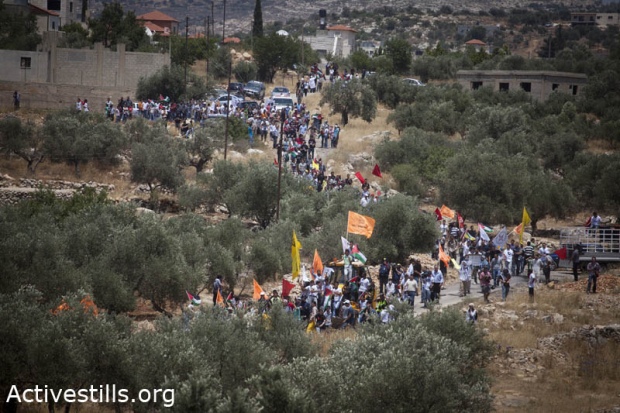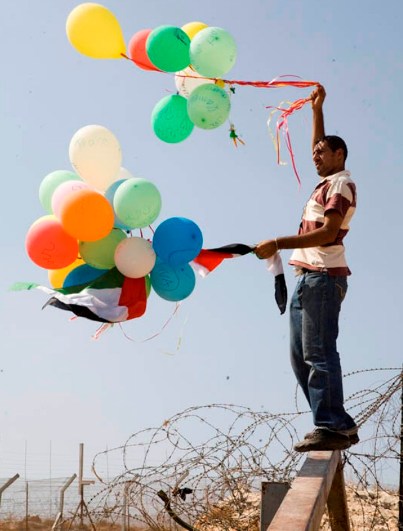Hundreds gathered in the West bank village to witness the removal of the Separation Wall after more than six years of protest, but the IDF was in vindictive mood
Bil’in, West Bank – It was a hot Friday in Bil’in – one of those early summer days here that remind you what to expect come August. The crowd at the village’s center was unusually large: The weekly march to the fence—a protest which made this village an international symbol of unarmed resistance—was to take the form of a celebration, after the Israeli army has began moving the infamous barrier that separated Bil’in’s people from their land.
Some context: Instead of having its separation wall on the Green Line—the internationally-recognized border until 1967—Israel decided to have it run deep into the Palestinian territory, cutting through villages and neighborhoods, separating farmers from their lands and families from their loved ones, and most important, annexing to Israel lands which had excellent market value, for their proximity to the Israeli cities along the Mediterranean coastline. Under the pretext of “security concerns,” communities like Bil’in, Nil’in and Budrus saw their fields being taken away, olive trees uprooted, and valuable land annexed to nearby settlements.
Palestinian residents of these villages made two important choices: To fight for their lands—the source of most of their livelihood–and in doing so, to use popular, unarmed resistance. It wasn’t something new for Palestinians–general strikes and mass protests were common in the years leading to the first Intifada–only that this time, the Palestinian farmers weren’t alone: Almost from the beginning of the protest against the security barrier they were joined by international and Israeli activists.
You can read about the role these activists played in the struggle, and the effect it had on the Israeli society in this piece Joseph Dana and I wrote for The Nation a few months ago.
Every week, and sometimes every day, Palestinians and activists would march to site of the planned wall, confront the army and try to reach the lost lands. Some tied themselves to the bulldozers, while others sat on the road in front of it for hours. In places where the work was completed, the protesters tried to make it to the wall or the fence, occasionally crossing or cutting it. They were met with beating, tear gas, arrests and even live bullets.
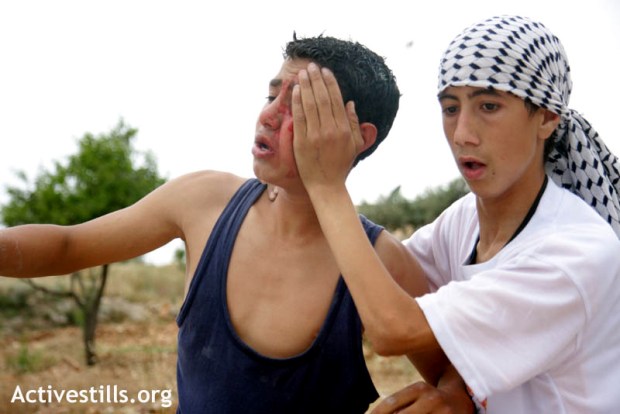
Around the time the protest began, the people of Bil’in filed a petition to the Israeli high court, demanding the barrier be removed and their land returned to them. It was not an easy decision on their part: Petitioning to court is seen as recognition of the Israeli occupation and the authority of its institutions over the lives of Palestinians in the West Bank, who have no civil rights or representation in those institutions. But the need to get even some of the land back overcame this argument.
The Israeli Supreme Court is a relatively liberal institution, but at the same time, it is extremely hostile to Palestinians – contrary to its public image, the court rarely rules against settlements or the army, and in most cases it wouldn’t even hear Palestinian petitioners. This time, however, even the Israeli court couldn’t ignore the obvious attempt to rob Bil’in’s people of their property. In a landmark verdict against the army and the defense ministry, the court ruled that the land was taken from Bil’in not to increase security, but to make way for the nearby mega-settlement Modi’in Ilit. It ordered a new barrier to be constructed in a route that would have some of the land returned to the people of Bil’in.
The court didn’t order the removal of Modi’in Ilit settlement, or the return of the land already built upon. It never does.
What happened next was even more shameful: the army didn’t carry out the verdict. Months and years passed, and the barrier–part fence, part wall—wasn’t moved. Only after an escalation of the demonstrations and a threat of contempt of court on behalf of the defense establishment, did the work on the new barrier begin.
A few days ago, after more than six years of struggle, the removal of the old security barrier near Bil’in began. the new barrier, already seen in the hills surrounding the village, will be a concrete wall.
[youtube]http://www.youtube.com/watch?v=DXS9JNLg6Bs[/youtube]
All these years, the protest in Bil’in continued. Every Friday, dozens of Bil’in residents marched in the direction of their lost lands. Occasionally, some kids hurled stones at the soldiers, but most of the time the protest was peaceful and creative. Yet it was met with brutal oppression: Hundreds of people were injured. Two – a brother and a sister – killed. Warning – graphic images]. Dozens of Palestinians, many of them minors, were arrested and held without trial for months in military prison. At nights, the army raided the village’s homes (as seen in the video above, one of many), searching for suspects in “incitement” offenses, i.e. organizing protest.
One of these organizers, Abdallah Abu Rahmah, was tried for one year in military prison. When he finished his term, rather than releasing him, the army simply kept Abu Rahmah in prison, and meanwhile appealed the sentence. While serving his time, Abdallah met in prison his cousin, Adeeb, who was also arrested, tried and imprisoned. 99.8 percent of Palestinians’ trials end in conviction. Watch this emotional outburst by Adeeb in front of the soldiers in one of the protests:
[youtube]http://www.youtube.com/watch?v=-St2hn_qPwE&[/youtube]
Both Adeeb and Abdallah remained men of peace. Like the rest of the people of Bil’in, they didn’t let their persecution change them. During the worse days of the struggle, they kept declaring that they are fighting the army and the occupation, not Israelis or Jews. When Jawaher Abu Rahma died from IDF tear gas, her family and friends invited the Israeli activists to her funeral.
Here are some things Abdallah Abu Rahmah wrote in a public letter from Ofer military prison. The entire text can be found here. It’s more than worth reading.
I have been accused of inciting violence: this charge is also puzzling. If the check points, closures, ongoing land theft, wall and settlements, night raids into our homes and violent oppression of our protests does not incite violence, what does?
Despite the occupations constant and intense incitement to violence in Bil’in, we have chosen another way. We have chosen to protest nonviolently together with Israeli and International supporters. We have chosen to carry a message of hope and real partnership between Palestinians and Israelis in the face of oppression and injustice.
.
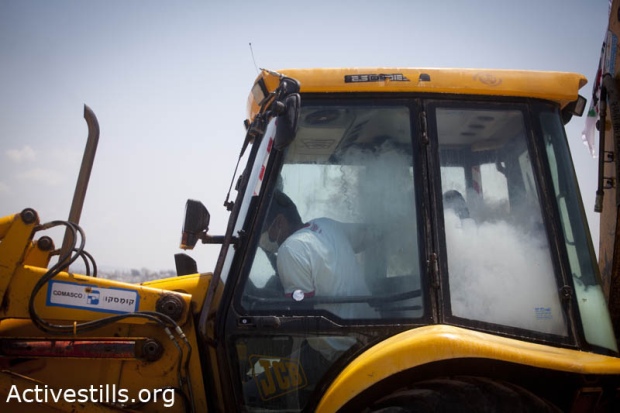
Politicians love to co-op success, so Bil’in saw visits from Palestinian PM Salam Fayyad and Israeli Palestinian MK Muhamad Barakeh prior to yesterday’s festive protest. There were around 40 Israelis present, and many international activists. A few hundred Palestinians led the march. A pickup truck with large speakers played music. At the village’s edge, a bulldozer joined the convoy—the people of Bil’in wanted to take part in dismantling the fence that had become the symbol of their misfortunes, and their lack of freedom.
The army had other plans. When the bulldozer approached the old fence, dozens of tear gas canisters were shot simultaneously at the crowd. Live fire was used to stop the bulldozer. A teargas grenade penetrated the driver’s cockpit. He barely made it out alive out. The rest of the crowd—unarmed and not threatening anyone—was sprayed with “skunk,” a stinking liquid, one of the most humiliating and dehumanizing crowd control weapons there is (and naturally, an Israeli invention). A few brave Palestinians in storm suits were trying to collect samples of the awful liquid (to be analyzed later, I was told), before collapsing from the effect of the smell and the gas. It all happened so fast that many members of the media didn’t have time to put on their gas masks and started chocking themselves.
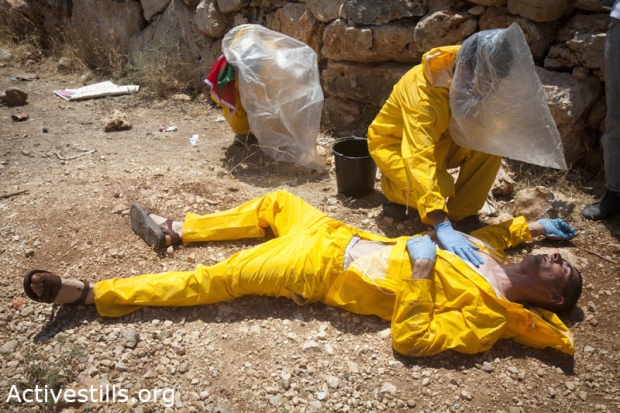
Standing a couple of hundred meters back, I couldn’t open my eyes and could feel my throat burn. I figure the army shot around 60 or 70 canisters at the protesters.
As we walked back to the village, everyone around me was coughing and choking. Yet the spirit was high. The unbelievable violence – aimed against unarmed people, for the defense of a fence that is already been taken down (the new barrier is up and ready for a long time now), showed how scared and confused the army is, how lost it is because of the immoral and self-destructive mission it carries out.
In the next few days, the army will continue to dismantle the fence it so vigorously protected yesterday.
The people of Bil’in might continue the weekly demonstration. Even with the removal of the old barrier and the construction of a new one, much of their land won’t be returned to them. The simple fact is that as long as the occupation goes on, the Palestinians have every right to resist it.
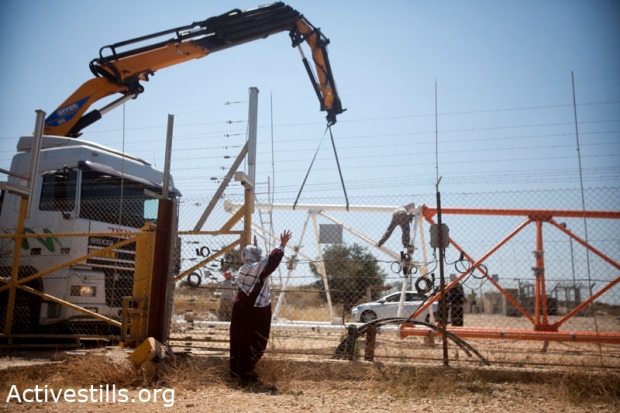
Whether they chose to do so, or prefer to heal their community from the long struggle – it’s up to them. But the victory of Bil’in’s people—however partial or limited it was—has taught us a valuable lesson: Israel will have to either give up the occupation or to considerably escalate its methods for maintaining it, at a growing cost. Either way, the occupation’s days are numbered.
—————
Watch 972’s Roee Ruttenberg’s video report from June 24 protest in Bil’in here.


